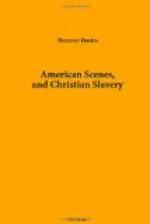In the afternoon of my first Sabbath at Baltimore I found, after much inquiry, a congregation of coloured people, who were some sort of Methodists. My wife and I were the only white people in the place. We were treated with great politeness, and put, not in a pew apart by ourselves, but in one of the best places they could find, in the very midst of the congregation. A serious-looking coloured man opened the service, with great propriety of manner and expression. He was the regular pastor. A black man, a stranger as I understood, preached. His text (he said) was, “Behold, I come quickly;” and they would find it in the Book of Revelation. But chapter and verse were not given, nor had he the Bible open in Revelation at all. I suspected that he could not read; and that suspicion was confirmed by the amount of nonsense which he soon uttered. At first his words were “few and far between,” uttered in a tone of voice scarcely audible. Soon, however, he worked both himself and his audience into a tremendous phrenzy. The burden of his song was—how John had lived to a very great age, in spite of all attempts to put him to death; how his enemies had at last decided to try the plan of throwing him into a “kittle of biling ile;” how God had said to him, “Never mind, John,—if they throw thee into that kittle, I’ll go there with thee,—they shall bile me too;” how John was therefore taken up alive; and how his persecutors, baffled in all their efforts to despatch him, ultimately determined to throw their victim upon a desolate island, and leave him there to live or perish as he might. During the delivery of all this nonsense, the laughing, the shouting, the groaning, and the jumping were positively terrific. It was Methodism gone mad. How disgraceful, that American Christians, so called, with all their schools and colleges, and with all their efforts to send the Gospel to Africa, should leave these people at their very doors thus to feed upon “husks” and “ashes!” Between 500 and 600 people were listening to this ignorant man, giving as the pure and positive word of God what was of very doubtful authority, intermingled with the crudities of his own brain. I wished to stay through the service, and perhaps at the close express my fraternal feelings; but I was so shocked and grieved at this ranting exhibition that I felt it unwarrantable to remain.
Leaving these unfortunate people, we peeped into two cathedral churches,—that of the Church of England, or (as it is here called) the Protestant Episcopal Church, and that of the Church of Rome. Both buildings are very splendid. We had been in the former some time before we felt quite sure that we were not in a Popish place of worship, so papistical were its aspect and arrangements. It was evident that Puseyism, or Popery in some form, had there its throne and its sceptre. The avowedly Popish cathedral was crowded with worshippers; and, to the shame of Protestantism be it spoken, black and coloured people were there seen intermingled with the whites in the performance of their religious ceremonies! The State of Maryland, of which Baltimore is the capital, having been first settled by a colony of Roman Catholics, might be expected to be a stronghold of Popery. Yet, it is not so. The adherents of that system are but a small minority of the population.




